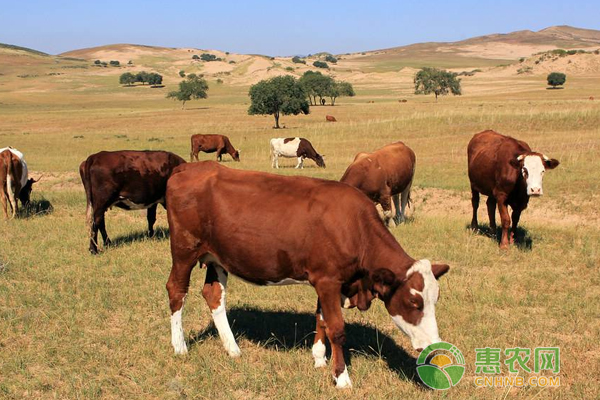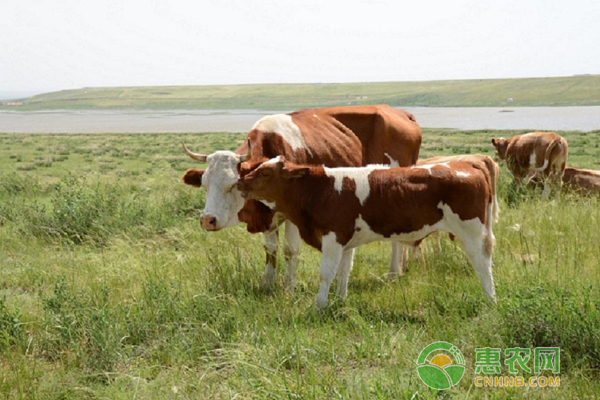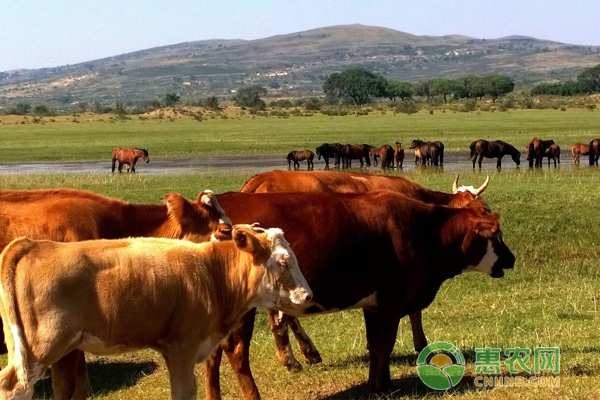Analysis of characteristics of occurrence of bovine disease and prevention and control measures
Cattle farming plays an important role in the aquaculture industry, so the breeding is naturally more, so how can the breeding cattle grow healthily? It is necessary to understand the skills of cattle breeding, the characteristics of disease occurrence and prevention and control measures. The following are the characteristics of the occurrence of cattle disease and prevention and control measures, I hope to help the growers!
At this stage, the development of China's cattle industry is accelerating, and large-scale and intensive farming is gradually on the right track. The problem at any time is that the incidence of bovine infectious diseases is increasing and the variety is increasing. How to do a good job in disease prevention and control in the process of raising cattle, reducing economic losses has become a top priority. To fundamentally solve this problem, we must clarify the characteristics and development trends of cattle diseases in China today, and adopt targeted prevention measures to ensure the development of the cattle industry.

1 Characteristics of bovine disease
1.1 The incidence of disease types is high
In recent years, China's cattle industry has developed rapidly, the number and scale of breeding has been increasing, trade has been frequent, and the flow of cattle and related products has accelerated. At the same time, the incidence of cattle diseases has been caused by imperfect cattle quarantine monitoring systems and improper diagnosis and treatment. No high. Infectious diseases with high incidence include foot-and-mouth disease (FMD), bovine rotavirus (BRV) infection, bovine coronaviridae (BCV) infection, malignant catarrhal fever (malignant catarrhal fever) MCF), bovine epizootic fever (BEF), colibacillosis, salmonellosis, brucellosis, tuberculosis and paratuberculosis. In addition, many new diseases have emerged and become prevalent, such as Bovine's disease, heart disease, Zhongshan disease, Akabane disease, bovine viral diarrhea virus (BVD/MD), bovine infectious rhinotracheitis (infectious) Bovine rhinotracheitis, IBR), etc. Among them, BVD/MD and IBR, China's current lack of targeted detection methods and effective vaccines, has become one of the most headaches in China's cattle industry.
1.2 Increasing incidence of bovine zoonotic diseases
At present, most of the cattle farms in China have adopted intensive breeding methods. More and more cattle-borne zoonotic diseases have begun to cause serious harm to food safety and human health. Such diseases mainly include brucellosis, tuberculosis, anthrax, campylobacter diarrhea, salmonellosis, leptospirosis, and Q fever. At present, the prevalence of brucellosis in cattle raising in China is more serious, and the positive rate of individual cattle farms is as high as 60%. In addition, the prevalence of tuberculosis in China is worrying. It is reported that China is one of the countries with the most serious tuberculosis epidemic in the world. Studies have shown that a large part of the disease of human tuberculosis originates from cattle. Tuberculosis tests were carried out on 1,187 cows in 12 provinces including Xinjiang, Hebei and Ningxia. The positive rate was 24.1%, and the group positive rate was 54.6%.
1.3 Enhanced bacterial resistance
For most cattle farmers in China, multiple infections and mixed infections are among the most difficult problems in the production process. Among them, yak diarrhea, endometritis and mastitis are the most common. Many diseases occur at the same time, and cross-infection between pathogens; mixed infections between bacteria, fungi, and viruses make the disease difficult to diagnose. In addition, due to the abuse of clinical antibiotics, bacterial resistance has increased, and drug-resistant strains have increased, further increasing the diagnosis and prevention of bovine diseases.

1.4 High incidence of reproductive disorders and leg and hoof disease
At this stage, reproductive disorders are also a difficult type of prevention in cattle diseases. The factors that cause bovine reproductive disorders are divided into two categories: biological and abiotic. Biological factors mainly include bacteria, mycoplasma, viruses, etc.; abiotic factors are common genital malformations, reproductive dysfunction, improper feeding and management, and reproductive technology failure. Nowadays, the density of large-scale breeding has increased, and the reproductive disorders of dairy cows have become increasingly serious. Repeated infertility, endometritis, genital diseases such as ovarian rest, ovarian insufficiency, delayed ovulation, persistent corpus luteum, and ovarian cysts have increased significantly.
In addition, the variety of bovine foot and hoof disease is increasing, and common hoof fork rot, hoof ulcer, laminitis, rot rot disease, polyarthritis, and hoof deformation. Foot and hoof disease seriously affects the normal movement of cattle, and it also causes the performance of cattle to decline, which is often eliminated in time, causing serious economic losses to the cattle industry.
1.5 Increased nutritional metabolic diseases
The modern cattle farm has a high degree of intensification, and the cattle movement is small. Many cattle are prone to nutritional metabolic diseases, especially the perinatal dairy cows have a higher incidence, mainly ketosis, fatty liver and production sputum. The occurrence of these metabolic diseases is closely related to excessive feeding of concentrates, reduction of dry matter intake, and imbalance of inorganic salt content in the body. Previously, there was no correlation between various diseases such as ketosis, fatty liver, placenta, ruminal acidosis, abdomen dislocation, and endometritis. Existing studies have shown that there is an intrinsic link between these diseases, and the various functions of the cows in the perinatal period change. If the disease invasion may cause a chain reaction of various systems, the incidence of various diseases will increase greatly, and even appear. The phenomenon of multiple diseases. The more high-yielding cows, the higher the incidence.
1.6 High incidence of sudden death and Clostridium diseases
These diseases mainly include malignant edema, anthrax, intestinal toxemia, etc., and most occur in the rainy season in areas with excessive humidity or poor sanitation. Many of these diseases can have a serious impact on human health, especially anthrax.
2 Current trends in cattle diseases
In different countries and regions, the occurrence characteristics and epidemic situation of bovine diseases have great geographical differences. China's cattle industry has a wide range of economic and trade, and the cattle movement speed is fast. Coupled with the problems of feeding mode, management level, and disease prevention and control system, the incidence of bovine infectious diseases in China is high and difficult to control.
2.1 The incidence of infectious diseases with diarrhea is increasing and persistent infection
The epidemic situation causing bovine diarrhea is more serious in China. Both yak and adult cattle have morbidity. The main causes of diarrhea in newborn yak are Escherichia coli and salmonellosis. BVD/MD, Campylobacter diarrhea, paratuberculosis, BRV infection, which are harmful to adult cattle, are more common. BCV infection. Fu Caixia and others tested 1 650 serum samples from 31 dairy farms in Beijing. The positive rates of BVD, BCV and BRV were 48.2%, 57.2% and 52.2%, respectively. He Meilin and others tested 1070 bovine serum, and the positive rates of BVDV, BCV and BRV were 44.3%, 84.1% and 94.4%, respectively. It shows that BVD, BCV and BRV infections are common in China's cattle industry, and the infection rates between different cattle fields are quite different.
2.2 Increased incidence of respiratory infections
There are many types of infectious diseases that cause bovine respiratory symptoms. The common causes in China include bovine Pasteurellosis, bovine tuberculosis, bovine purulent cryptobacteria, yak local epidemic pneumonia, IBR, bovine syncytial virus pneumonia, and cattle parasitic epidemics. Sexy, BEF, etc. According to the research report, 803 serum samples from Xinjiang were tested, and the positive rates of BRSV, BPIV and BV were 54.17%, 33.75% and 65.13%, respectively. Zhu Haiming reported that the positive rate of IBRV in cattle in Beijing, Shandong, Hebei, Henan, Sichuan and other provinces was 29.45%. Shi Dongmei et al reported that the positive rate of IBRV antibody in dairy cows in Henan Province was 59.29%.

2.3 Bovine infectious diseases based on reproductive disorders
There are many kinds of diseases causing bovine reproductive disorders, and these diseases have a great impact on the breeding industry. These diseases in China mainly include bovine brucellosis, bovine genital tract bacillary disease, Zhongshan disease, red feather disease, and cattle local epidemic. Sexual abortion, etc., in which bovine brucellosis occurs most widely, followed by epidemic abortion in cattle. Bovine brucellosis is widespread and harmful to humans and animals. In recent years, due to the increase in the scale of cultivation and the acceleration of economic and trade, the circulation and circulation rate of cattle have increased, making the disease frequent and difficult to control.
2.4 Parasite-based bovine infectious diseases
The parasitic diseases of cattle in China are mainly digestive tract parasitic diseases, such as coccidiosis, cryptosporidiosis, schistosomiasis, dysentery, moniz tsutsugamushi, etc., among which cryptosporidium patients Suffering from the national distribution, Xu Xueping's investigation showed that the infection of Cryptosporidium is serious among humans and animals in China. The infection rate is between 0.8% and 13.3%, and the infection rate of cattle is 27%. There are some respiratory parasites, such as the nematode, the original roundworm. Guizhou and other places are areas where blood parasites occur frequently, mainly including red body and pear-shaped worms, and double-bud babies.
2.5 Bovine infectious diseases characterized by anemia and jaundice
Blood parasitic diseases basically have symptoms of anemia and jaundice. Common bovine blood parasitic diseases in China include Babesia, Tyler's disease, East trematode disease, Leptospirosis, bovine no-plasma disease, and Mycoplasma bovis. Sick and so on.
2.6 Other infectious diseases
Bovine diseases that cause oral mucosal erosion or ulceration mainly include FMD, BVD/MD, MCF, Ibaraki disease, and papular stomatitis. Currently the main epidemic and papular stomatitis.
Bovine diseases that cause granuloma and malignant tumors of the body are mainly bovine leukemia and actinomycosis. Bovine leukemia occurs mainly in 4-8 year old cattle under natural conditions. Bovine actinomycosis is mainly cattle of 2 to 5 years old, mostly sporadically occurring.
3 Problems in the prevention and control of disease
3.1 Lack of special funds for diagnosis and monitoring of animal diseases
At present, the basic construction of grassroots animal epidemic prevention system in China is basically in place, and animal disease surveillance and diagnosis can be carried out year round. However, due to the lack of special funds for animal disease surveillance and diagnosis, the cost of consumable materials such as reagents, drugs, test strips, etc. is relatively high. The animal disease prevention and control institutions are non-profit service units, and no extrabudgetary funds are invested. Therefore, laboratory laboratory diagnosis The monitoring and inspection work has not been functioning properly.
3.2 Single disease control measures for farmers
At present, many farming owners in China are the owners of real estate enterprises. They have little knowledge of the expertise in breeding technology and disease prevention and control, and have not received professional training from animal husbandry systems. For them, the main way to obtain professional knowledge is the promotion activities of feed and veterinary drug dealers, which has led many farms to mistake vaccination as the only important factor in preventing disease, but neglected feeding management, disinfection and purification, quarantine testing, The comprehensive prevention and control of harmless treatment, etc., can not effectively control the epidemic.
3.3 Farms do not meet the epidemic prevention conditions
The site selection, layout, facilities and equipment, and personnel quality of some large-scale farms do not meet the requirements for epidemic prevention. In the site selection, only land approval and capital investment are considered, development and safety protection are not considered, and awareness of environmental protection and disease prevention and control is not established; no scientific and practical, non-reasonable design of functional areas, clean areas and contaminated areas There is no effective isolation between them, and there is no harmless treatment place and equipment; some farms do not have vehicle disinfection tanks and personnel disinfection equipment even at the entrance.
3.4 blind use of drugs
Many domestic farms are not equipped with professional veterinarians, there is no reasonable dosing program, and the cattle are often treated according to experience. Often, medications are inadequate or even wrong. In particular, some antibiotics can not be taken orally orally. The normal flora is inhibited or killed. The harmful bacteria multiply, causing dysbacteriosis and even "superbugs", which ultimately leads to no cure. Some farms add veterinary drugs to the feed for long-term consumption or excessive use of veterinary drugs for the treatment of diseased herds, which further leads to increased bacterial resistance.
3.5 Staff professional level is not high
The quality of farm staff is lack of scientific knowledge, and the low degree of specialization is a common problem in the current cattle industry. Most farms are not equipped with licensed veterinarians. Farm management personnel and breeders have little knowledge about animal disease prevention and control, lack of common knowledge of disease and observation, and can not observe the initial symptoms of animal diseases, often delaying the diagnosis and treatment time. , causing economic losses. The staff of many large-scale farms are low-educated personnel who graduated from primary and secondary schools. There are very few specialists and above, not to mention practicing veterinarians. These staff members have not systematically studied animal husbandry expertise, even The most basic pre-job training classes have not participated, and there is no way to scientific farming.
3.6 The disease prevention and control service system is not perfect
The disease prevention and control service system in many areas is not perfect, especially in remote areas at the grassroots level. Many animal husbandry technology promotion is not carried out by special personnel. Most of them are indirectly completed by feed and veterinary drug distributors. Due to the inconsistent management of such personnel and the lack of technical level, coupled with the pursuit of maximizing their own interests, the farming owners cannot learn systematically. Knowledge, the diagnosis and treatment of farms are not effectively protected. In addition, at the grassroots level of the aquaculture industry, the staff of many grassroots units have not experienced the experience of the scale field, and the new veterinary concept, new knowledge, and new technology are poorly updated, and it is difficult to be competent in disease prevention and control services. Therefore, the most urgent task of disease prevention and control is to establish a professional disease prevention and control service department that is consistent with regional farming methods.
4 prevention and control strategies
4.1 Strengthening feeding management
Scientifically and rationally plan the layout of the field. Reasonable greening of the field, while ensuring air quality, can also play a certain role in the isolation of diseases. The pens are regularly disinfected, and the ventilation is kept dry and there is no accumulation of manure, which provides a good living environment for the cattle. Scientific breeding, ensuring a comprehensive and balanced nutrition of the cattle, and enhancing their own immunity. Regular deworming and vaccination according to the immunization plan. Reduce noise and avoid stress on the herd.
4.2 Do a good job in quarantine prevention
When introducing a herd, do a good job in quarantine work to avoid bringing it into the pathogen. Develop a scientific and rational immunization plan, and vaccinate according to the immunization plan to reduce the incidence of cattle. Regular deworming and testing. Timely isolation of infected cattle to prevent the spread of pathogens; timely response strategies to reduce economic losses.
4.3 Strengthening supervision in the field of circulation supervision and quarantine circulation
The quarantine of the place of origin should be the key point to ensure the safety of the product before it goes on the market, and the veterinary epidemic prevention department issues a quarantine certificate for market quarantine inspection. Strengthen the supervision of trans-regional cattle transportation, and the infected areas cannot be circulated to the non-epidemic areas; before the transshipment, strict disease detection should be carried out, and the test can pass the transfer. Breeding
A filing system should be established to establish a cattle file to enable cattle to be traced and the disease to be traceable. The market supervision department shall strengthen the disinfection and quarantine work. In addition to checking the quarantine certificate of the place of origin, it is necessary to increase the test items according to the local epidemic characteristics and cut off the spread of the disease from the root cause.
4.4 Strengthening scientific and technological research and development
The lack of research funding is the reason why many scientific research projects cannot be carried out smoothly. Research on the major diseases affecting the cattle industry also has such problems, which requires the government to increase investment in scientific research, support and encourage the development of scientific research projects, the transformation of scientific research results and the promotion in production practice. Use scientific and technological means and scientific research results to improve the level of breeding.
5 Conclusion
With the development of China's cattle industry, the nutritional demand and yield level of cattle have gradually increased. Factory and large-scale farming have become the main development direction of the cattle industry, and related economic and trade are also increasing. To this end, targeted preventive measures must be taken to effectively prevent the occurrence and spread of cattle diseases. Vaccination is a must for prevention and control of infectious diseases. At present, most of the bovine infectious diseases in China have effective vaccines, but some diseases such as brucellosis, infectious rhinotracheitis, and viral diarrhea mucosal diseases have been used. It has a good immune effect, but there is a problem of detoxification, infection of the fetus, abortion, and stillbirth. Therefore, in order to ensure the healthy development of the entire cattle industry, it is urgent to increase investment in scientific research, carry out a lot of work in the optimization of traditional vaccines, research and development of new vaccines, and develop safe and efficient new vaccines as soon as possible.
The above is the characteristics analysis and prevention and control measures of the occurrence of cattle disease compiled by Huinong.com, and the farmers are rushing to collect!
X Ray High Collar Waistcoat Apron
Dental Lead Apron,Patient Lead Apron,Dental Radiation Lead Apron With Collar,Lead Aprons With Thyroid Collars
Longkou Kangxie Medical Instrument Co., Ltd , https://www.kangxiemedical.com